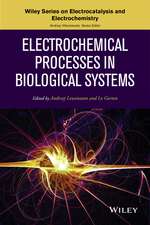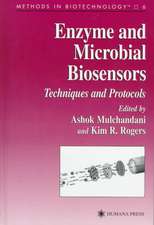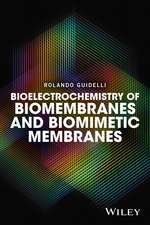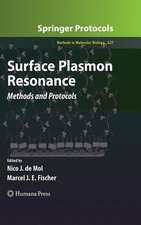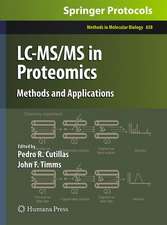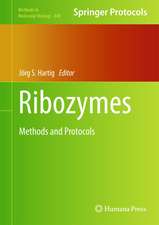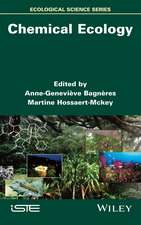Affinity Biosensors: Techniques and Protocols: Methods in Biotechnology, cartea 7
Editat de Kim Rogers, Ashok Mulchandanien Limba Engleză Paperback – 8 oct 2011
| Toate formatele și edițiile | Preț | Express |
|---|---|---|
| Paperback (1) | 632.66 lei 6-8 săpt. | |
| Humana Press Inc. – 8 oct 2011 | 632.66 lei 6-8 săpt. | |
| Hardback (1) | 647.27 lei 6-8 săpt. | |
| Humana Press Inc. – 17 apr 1998 | 647.27 lei 6-8 săpt. |
Din seria Methods in Biotechnology
- 15%
 Preț: 648.74 lei
Preț: 648.74 lei - 15%
 Preț: 656.43 lei
Preț: 656.43 lei - 15%
 Preț: 650.69 lei
Preț: 650.69 lei - 15%
 Preț: 639.90 lei
Preț: 639.90 lei - 18%
 Preț: 953.52 lei
Preț: 953.52 lei - 18%
 Preț: 969.93 lei
Preț: 969.93 lei - 18%
 Preț: 954.14 lei
Preț: 954.14 lei - 18%
 Preț: 952.57 lei
Preț: 952.57 lei - 18%
 Preț: 963.15 lei
Preț: 963.15 lei - 18%
 Preț: 961.23 lei
Preț: 961.23 lei - 15%
 Preț: 652.31 lei
Preț: 652.31 lei - 15%
 Preț: 651.19 lei
Preț: 651.19 lei - 18%
 Preț: 953.52 lei
Preț: 953.52 lei - 18%
 Preț: 962.35 lei
Preț: 962.35 lei - 18%
 Preț: 955.56 lei
Preț: 955.56 lei - 15%
 Preț: 649.87 lei
Preț: 649.87 lei - 18%
 Preț: 964.71 lei
Preț: 964.71 lei - 15%
 Preț: 648.05 lei
Preț: 648.05 lei - 15%
 Preț: 643.99 lei
Preț: 643.99 lei
Preț: 632.66 lei
Preț vechi: 744.30 lei
-15% Nou
Puncte Express: 949
Preț estimativ în valută:
121.06€ • 126.73$ • 100.17£
121.06€ • 126.73$ • 100.17£
Carte tipărită la comandă
Livrare economică 07-21 aprilie
Preluare comenzi: 021 569.72.76
Specificații
ISBN-13: 9781617370663
ISBN-10: 1617370665
Pagini: 264
Ilustrații: XII, 249 p.
Dimensiuni: 152 x 229 x 14 mm
Greutate: 0.36 kg
Ediția:1998
Editura: Humana Press Inc.
Colecția Humana
Seria Methods in Biotechnology
Locul publicării:Totowa, NJ, United States
ISBN-10: 1617370665
Pagini: 264
Ilustrații: XII, 249 p.
Dimensiuni: 152 x 229 x 14 mm
Greutate: 0.36 kg
Ediția:1998
Editura: Humana Press Inc.
Colecția Humana
Seria Methods in Biotechnology
Locul publicării:Totowa, NJ, United States
Public țintă
ResearchCuprins
Enzyme Biosensors.- Principles of Affinity-Based Biosensors.- Immunobiosensors Based on Thermistors.- Affinity Biosensing Based on Surface Plasmon Resonance Detection.- Immunosensors Based on Piezoelectric Crystal Device.- Immunobiosensors Based on Evanescent Wave Excitation.- A galactose-specific affinity hollow fiber sensor based on fluorescence resonance energy transfer.- Fiberoptic immunosensors with continuous analyte response.- Immunobiosensors based on grating couplers.- Receptor biosensors based on optical detection.- Biosensor-Related Techniques.- lmmunobiosensors based on ion-selective electrodes.- Biosensors based on DNA intercalation using light polarization.- ISFET affinity sensor.- Liposome-Based immunomigration assays.- Isolated receptor biosensors based on bilayer lipid membranes.- Eukaryotic cell biosensor The Cytosensor microphysiometer.
Recenzii
"I enthusiastically recommend this book for anyone involved in the biosensor fields. . .allows one to quickly become knowledgeable in the field. . .very well written and organized, and it has a good index. The chapters are written by the noted experts who have developed each sensor type. . . an essential complement to its companion volume, which covers enzyme and microbial sensors."-John I. Peterson, NIH reviewing for Analytical Chemistry
Textul de pe ultima copertă
Affinity Biosensors: Protocols and Techniques is a major new work that describes how affinity biosensors are developed, constructed, and applied across the widest range of biological research. Here, scientists long-experienced with the construction and evaluation of these biosensors detail their most successful techniques and applications. The methods include protocols for affinity biosensors based on optical, electrochemical, thermal acoustic, and plasmon resonance techniques involving the use of antibodies, receptor, nucleic acids, liposomes, and eukaryotic cells. All the techniques are time-tested and sufficiently detailed to ensure robust and easily reproducible results. A companion volume, Enzyme and Microbial Biosensors: Protocols and Techniques, by Mulchandani & Rogers, concentrates on enzyme-biosensors based on potentiometric, amperometric, conductimetric, optical, and thermal transducers, as well as microbial biosensors based on amperometric and optical transducers.
Clearly the optimal starting point for all graduate students, postdoctoral and senior researchers, and technicians in academia, industry, and research establishments seeking rapid entry into the field of biosensors, Affinity Biosensors: Protocols and Techniques instantly becomes today's leading reference. Its step-by-step descriptions of various affinity biosensor techniques will allow both novices and experienced investigators alike successfully to apply these powerful new tools, and thus sharply enhance their laboratories' productivity.
Clearly the optimal starting point for all graduate students, postdoctoral and senior researchers, and technicians in academia, industry, and research establishments seeking rapid entry into the field of biosensors, Affinity Biosensors: Protocols and Techniques instantly becomes today's leading reference. Its step-by-step descriptions of various affinity biosensor techniques will allow both novices and experienced investigators alike successfully to apply these powerful new tools, and thus sharply enhance their laboratories' productivity.

